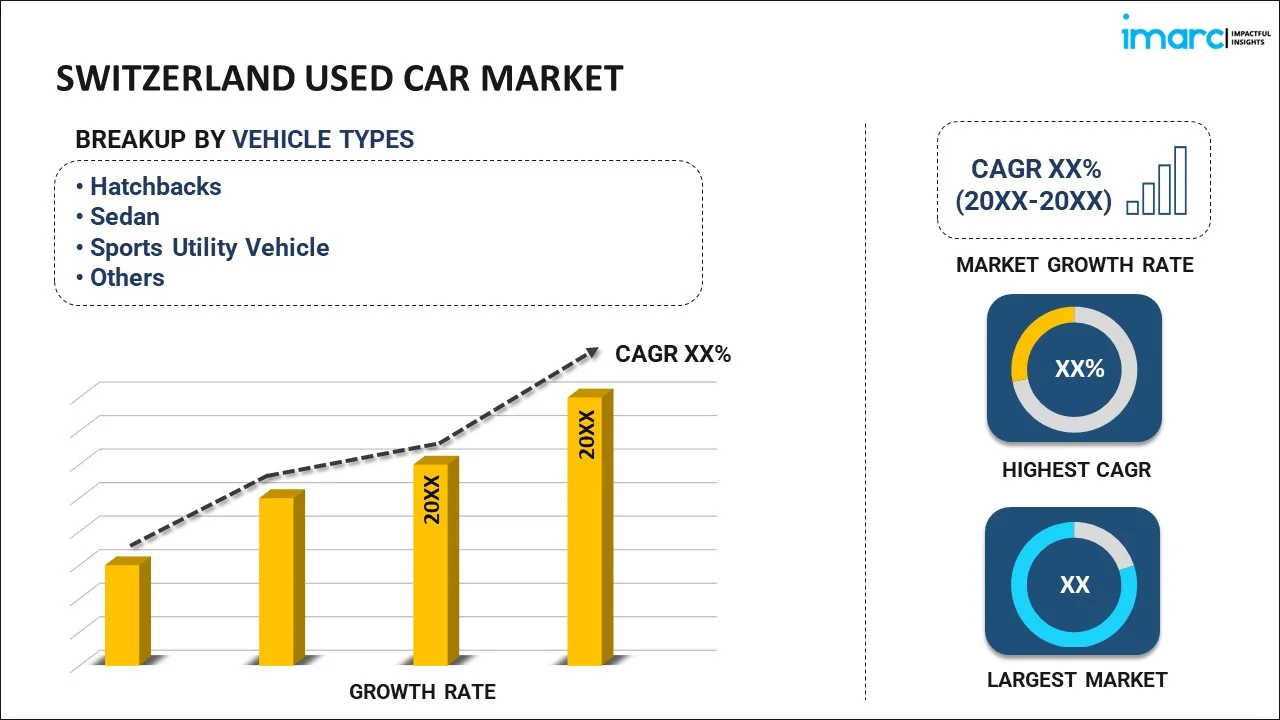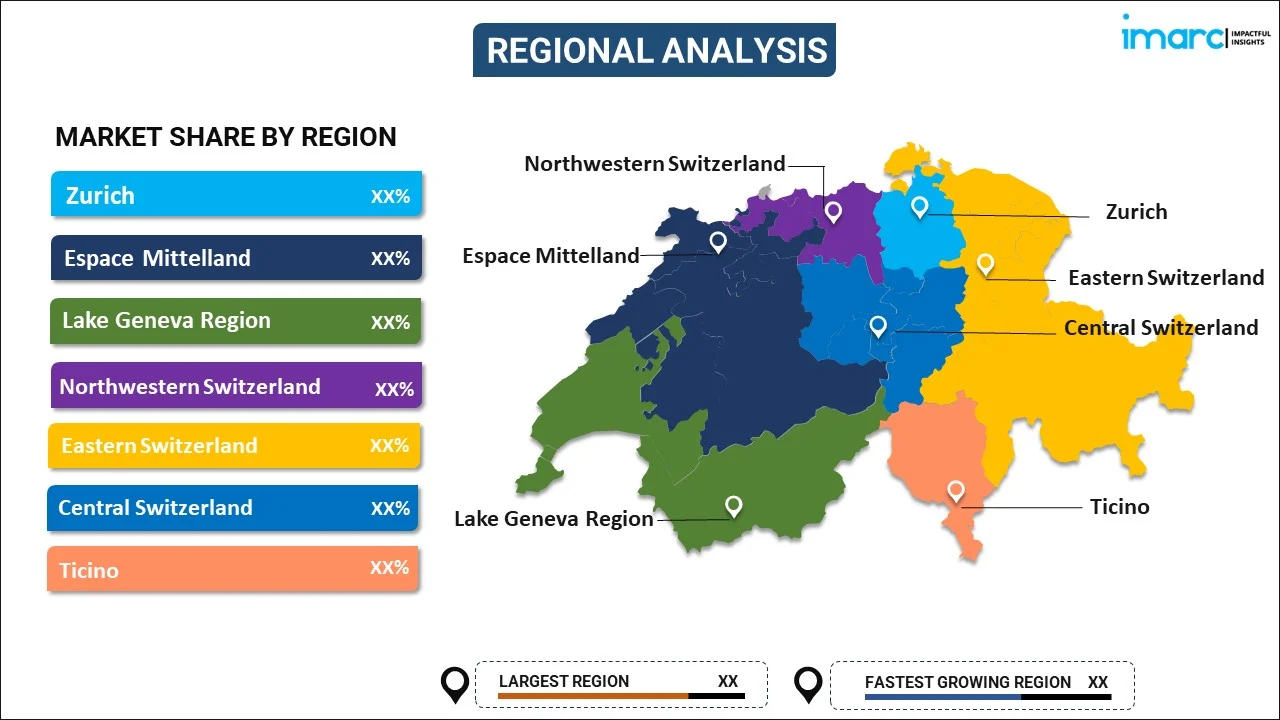
Switzerland Used Car Market Report by Vehicle Type (Hatchbacks, Sedan, Sports Utility Vehicle, and Others), Vendor Type (Organized, Unorganized), Fuel Type (Gasoline, Diesel, and Others), Sales Channel (Online, Offline), and Region 2025-2033
Switzerland Used Car Market Overview:
The Switzerland used car market size reached USD 2.1 Billion in 2024. Looking forward, IMARC Group expects the market to reach USD 4.2 Billion by 2033, exhibiting a growth rate (CAGR) of 7.2% during 2025-2033. Rising demand for affordable mobility, driven by high new car prices, boosts the used car market. Digital platforms and apps simplify buying, selling, and financing. Tech advancements like vehicle history reports and virtual showrooms build buyer confidence. Urban mobility needs and environmental awareness further accelerate interest in second-hand vehicles.
|
Report Attribute
|
Key Statistics
|
|---|---|
|
Base Year
|
2024
|
|
Forecast Years
|
2025-2033
|
|
Historical Years
|
2019-2024
|
| Market Size in 2024 | USD 2.1 Billion |
| Market Forecast in 2033 | USD 4.2 Billion |
| Market Growth Rate 2025-2033 | 7.2% |
Switzerland Used Car Market Trends:
Robust Demand for Affordable Mobility Solutions
One of the major factors that has contributed to the expansion in the sale and supply of used car Switzerland is the increased need for economic mobility in the country. This can be attributed to the soaring prices of new cars. According to industry reports, the Switzerland used car market size is estimated at USD 4.80 billion in 2024, and is expected to reach USD 6.73 billion by 2029, growing at a CAGR of 5.80% during the forecast period (2024–2029). This trend is especially widespread among the young and the first-time car owners who care more about the cost of a car than its other characteristics. Moreover, the certified preowned programs offered by the dealerships have gone a long way into convincing the consumer to opt for used cars as they are subjected to rigorous checks and tests, which includes warranty and guarantees assuring the customer of the car’s quality. The shift among consumers towards more economical and reliable modes of transportation is seen as a driving force behind the growth of the market.
Technological Advancements and Digital Marketplaces
Advancements in technology, including the adoption of digital platforms, are significantly influencing the Switzerland car market. Emil Frey Digital and Mercedes-Benz have forged a partnership to further enhance the digital experiences and solutions that underpin the international distribution of Mercedes-Benz vehicles and services. The two companies will work together on a new digital platform that will combine the best practices and solutions of Emil Frey Group and Mercedes-Benz. Technological advancements, such as use of social media and the development of applications, have made it easier to sell or buy used cars than before. These digital tools give detailed insights about the car history, price comparison, and detailed inspection for the cars, hence enabling the buyers to have better insights. Similarly, data analytics and artificial intelligence offer a greater way of matching the buyers with the most appropriate vehicle to suit their need, making the whole process of purchasing a vehicle a satisfying one. In 2022, AutoScout24, one of the leading online marketplaces in Switzerland, received around 25 million visitors and advertised over 750,000 vehicles.
Fleet Turnover by Companies Driving Used Car Supply
Car market in Switzerland is being shaped by steady renewal cycles of corporate fleets. Many businesses opt for short leasing terms, often between two to four years, which leads to a reliable flow of vehicles being offloaded once contracts expire. These company cars are typically well-maintained and equipped with modern features, making them attractive to private buyers looking for value without compromising on quality. This practice has created a dependable secondary supply, helping stabilize availability in a market often affected by supply chain delays. The strong demand for nearly-new cars among individuals, combined with regular corporate offloading, has made fleet turnover a key factor influencing stock levels and buyer expectations in the used car segment.
Rising Affluence Fueling Demand for Premium Second-Hand Cars
Higher disposable incomes in Switzerland are making luxury cars more accessible, even in the second-hand market. Many buyers who may not have considered a new premium vehicle are now turning to used models from brands like BMW, Audi, and Mercedes-Benz, which offer both prestige and performance at a more manageable price. The appeal of upgraded interiors, safety features, and high-end aesthetics is pushing demand for these cars, especially among younger professionals and first-time luxury car owners. This trend is reshaping the Switzerland auto market, where upper-tier models no longer sit on the lot for long, and pricing for well-maintained, high-spec vehicles continues to climb. Luxury is no longer reserved for the new car market alone.
Switzerland Used Car Market Segmentation:
IMARC Group provides an analysis of the key trends in each segment of the market, along with forecasts at the country level for 2025-2033. Our report has categorized the market based on vehicle type, vendor type, fuel type, and sales channel.
Vehicle Type Insights:

To get more information on this market, Request Sample
- Hatchbacks
- Sedan
- Sports Utility Vehicle
- Others
The report has provided a detailed breakup and analysis of the market based on the vehicle type. This includes hatchbacks, sedan, sports utility vehicle, and others.
Vendor Type Insights:
- Organized
- Unorganized
A detailed breakup and analysis of the market based on the vendor type have also been provided in the report. This includes organized and unorganized.
Fuel Type Insights:
- Gasoline
- Diesel
- Others
The report has provided a detailed breakup and analysis of the market based on the fuel type. This includes gasoline, diesel, and others.
Sales Channel Insights:
- Online
- Offline
A detailed breakup and analysis of the market based on the sales channel have also been provided in the report. This includes online and offline.
Regional Insights:

- Zurich
- Espace Mittelland
- Lake Geneva Region
- Northwestern Switzerland
- Eastern Switzerland
- Central Switzerland
- Ticino
The report has also provided a comprehensive analysis of all the major regional markets, which include Zurich, Espace Mittelland, Lake Geneva Region, Northwestern Switzerland, Eastern Switzerland, Central Switzerland, and Ticino.
Competitive Landscape:
The market research report has also provided a comprehensive analysis of the competitive landscape. Competitive analysis such as market structure, key player positioning, top winning strategies, competitive dashboard, and company evaluation quadrant has been covered in the report. Also, detailed profiles of all major companies have been provided.
Switzerland Used Car Market News:
- In April 2025, following Q1 results, Switzerland’s used car market showed growth with listings up 4.1% on AutoScout24. Electric vehicle prices continued to drop, though overall market prices stayed stable. Sales were quicker, especially for alternative drivetrains, mild hybrids rose 8.1%, and full hybrids 2.8%. SUVs held strong, minivan listings climbed 12.6%, while estate cars slipped 1.1%, signaling shifting preferences among Swiss buyers.
- In July 2023, Volkswagen Financial Services AG acquired a 50% stake in movon AG, a subsidiary of AMAG Leasing AG in Switzerland. This acquisition allows AMAG Leasing to concentrate on fleet leasing and providing full-service solutions equipped with digital tools for fleet owners and dealers.
- In May 2023, ALD Automotive took over 100% ownership of LeasePlan, a global leader in fleet management and mobility. This acquisition is set to enhance ALD Automotive's digitization efforts in the sales of new and used cars.
Switzerland Used Car Market Report Coverage:
| Report Features | Details |
|---|---|
| Base Year of the Analysis | 2024 |
| Historical Period | 2019-2024 |
| Forecast Period | 2025-2033 |
| Units | Billion USD |
| Scope of the Report | Exploration of Historical and Forecast Trends, Industry Catalysts and Challenges, Segment-Wise Historical and Predictive Market Assessment:
|
| Vehicle Types Covered | Hatchbacks, Sedan, Sports Utility Vehicle, Others |
| Vendor Types Covered | Organized, Unorganized |
| Fuel Types Covered | Gasoline, Diesel, Others |
| Sales Channels Covered | Online, Offline |
| Regions Covered | Zurich, Espace Mittelland, Lake Geneva Region, Northwestern Switzerland, Eastern Switzerland, Central Switzerland, Ticino |
| Customization Scope | 10% Free Customization |
| Post-Sale Analyst Support | 10-12 Weeks |
| Delivery Format | PDF and Excel through Email (We can also provide the editable version of the report in PPT/Word format on special request) |
Key Benefits for Stakeholders:
- IMARC’s industry report offers a comprehensive quantitative analysis of various market segments, historical and current market trends, market forecasts, and dynamics of the Switzerland used car market from 2019-2033.
- The research report provides the latest information on the market drivers, challenges, and opportunities in the Switzerland used car market.
- Porter's five forces analysis assist stakeholders in assessing the impact of new entrants, competitive rivalry, supplier power, buyer power, and the threat of substitution. It helps stakeholders to analyze the level of competition within the Switzerland used car industry and its attractiveness.
- Competitive landscape allows stakeholders to understand their competitive environment and provides an insight into the current positions of key players in the market.
Key Questions Answered in This Report
The used car market in Switzerland was valued at USD 2.1 Billion in 2024.
The Switzerland used car market is projected to exhibit a CAGR of 7.2% during 2025-2033, reaching a value of USD 4.2 Billion by 2033.
Increasing new-car prices and budget-conscious buyers drive demand for used vehicles in Switzerland. Rising ownership, especially in cities, fuels supply. Online platforms offering history reports, digital finance, and certified-pre-owned programs enhance trust. Stricter emissions rules and growing EV interest also shape vehicle mix dynamics.
Need more help?
- Speak to our experienced analysts for insights on the current market scenarios.
- Include additional segments and countries to customize the report as per your requirement.
- Gain an unparalleled competitive advantage in your domain by understanding how to utilize the report and positively impacting your operations and revenue.
- For further assistance, please connect with our analysts.
 Request Customization
Request Customization
 Speak to an Analyst
Speak to an Analyst
 Request Brochure
Request Brochure
 Inquire Before Buying
Inquire Before Buying




.webp)




.webp)












